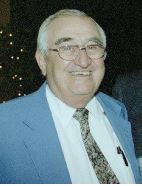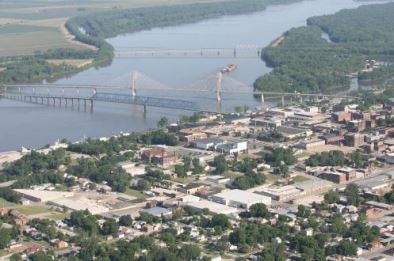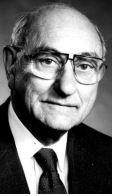How and Why Quincy, IL Became the Digital Capitol of the World

[November 2009] Few cities in the US have had as close a connection to the broadcast industry as Quincy, Illinois. Home to Gates Radio (now Harris Broadcast) and Broadcast Electronics, among other companies, Quincy has seen the industry move from early analog receivers to the digital systems of the last twenty years. Tom Yingst participated in some key parts of the story and therefore can share first-hand information.
Over the last 70 years or so, events in the Broadcast Industry led to Quincy, Ill., becoming the Broadcast Digital Center of the World. Not all of these events clearly pointed to this theme as they occurred but as we will show, certain key dates and events around the world from the 1930’s to the present time combined to bring Quincy to the center of digital technology.
Although I was deeply involved in VHF/UHF TV at Harris Broadcast (and throughout my career), it is important to note that market-driven advances in AM and FM were the major contributors to the designation of Quincy as the capitol of digital things (TV was more or less moved toward the digital world because of FCC Rules requiring analog TV to give way to High Definition Television (HDTV) to in 2009.
A Unique Vantage Point
I was fortunate to have a “front row seat” to observe many of the key events as my career took me from four years of teaching electronics starting in 1948 to a long tenure in broadcast manufacturing. Over the decades, I spent 23 years at RCA Lancaster, PA, 10 years at Eimac/Varian, three years at Varian/Continental and then 8½ years at the Harris Broadcast Division in Quincy – and working with all the major transmitter manufacturers as well as getting into the very exciting High Power RF Systems arena.
Along the way, I was associated with Gates Radio Company and later Gates Division of Harris (1957) for many years. Also, being directly involved as a supplier of TV and Radio Tubes and Circuits and application support for many years from RCA Lancaster, PA., and later Eimac/Varian in California, it was a perfect perch from which to see the growing digital side of the industry.
From a Small Start to Electronic Center
Quincy had a modest start on the road to becoming the Digital Capitol of the world when the Gates family formed Gates Radio there in 1922. Starting by selling wireless receivers and parts, Gates Radio eventually would become one of the best known names in broadcast equipment.

Quincy, IL, on the East bank of the Mississippi River
Over the years many manufacturers came to this small city in western Illinois. Motorola ran a huge TV set manufacturing factory in Quincy for thirty years (starting in the late 40’s) so a large force of local people were trained in electronics manufacturing when Gates (purchased by Harris in the mid-1950s) started to expand further. This appealed to Broadcast Electronics and others who have since moved to Quincy.
A major event happened during WWII, when RCA subcontracted the manufacture of some shortwave transmitter and other production equipment to Gates Radio in Quincy. As the years moved along, Gates got more and more involved in the audio and radio business – and as a result moved to several locations in Quincy, each being better suited for the broadcast transmitter world of the future.

RCA, and other companies like Westinghouse and GE, also were deeply involved in the development of TV for the consumer, with lots of work was being done in the development of radio and scientific systems. RCA Lancaster in fact became a major worldwide part of the exciting developments at this time.
Much later these companies ended up selling their transmitter lines, and this opened the gate for further expansion at Quincy.
The Transistor Age
Another key event in setting the stage for the forthcoming digital revolution in broadcasting came in 1948. The transistor (a solid state device to replace the vacuum tube) was invented at Bell Labs and, starting at low power levels, began to establish itself as an important component in anything electronic.
From the mid- to late 1950’s, and beyond, RCA was deeply involved in developing high power pulse transmitters in Lancaster, PA. RCA was also deeply involved in developing TV and FM tubes with associated circuitry, along with receivers, setting the stage for heavy emphasis on TV Broadcast Technology throughout the corporation.
During this time period I first noted that it takes lots of leadership and money to enter a new field like TV, with its associated systems like cameras and other studio equipment – and to work with the innovators at the time.
For example, Vladimir Zworykin, who invented the Iconoscope for TV cameras, was asked by the famous David Sarnoff how long it would take to get TV cameras and receivers ready for the general public. As the story goes, Zworykin stated that he needed $100,000 and several years to do the job. The actual time was said to be about 10 years and $50 Million to get this part of TV ready for the general public use.
That well demonstrates why you must have strong leadership along with high technology to enter a field like television and its associated electronics.
Higher and Higher Powered RF
With television requiring much higher-powered transmitters than radio used most of the time, RCA Lancaster became between 1950 and 1970 the center for Very High Power RF development in the world. They were also developing high performance tubes and circuits for RF transmitters for UHF, VHF, FM, AM and scientific systems.
One of the major systems developed at RCA was a test bed for radar applications in the Air Force. It used a newly developed high-power triode to run 5 MW peak, 300 kW average at 407 – 442 MHz. This was followed by a 2.5 MW peak, 150 kW average, 600 MHz system developed for missile detection. Both of these programs were major advancements in the “state of art” at the time.
On the radio side, RCA was involved with J.O. Weldon and Continental Electronics to install a high-power, 500 kW AM transmitter at XERF in Mexico, alongside the US/Mexico border. The power tube, identified as the 5831, was called a “bucket of bolts” and was. Yet, XERF would broadcast all over the US at nighttime. Later, this tube was used for high power VLF applications.
RCA was also deeply involved in developing and producing other high power projects:
- 27 MW high-power pulse systems for the Stanford Linear Accelerator.
- tubes and circuits for 200/400/600 MHz high-power radars.
- klystrons for the TV market
- tetrodes for a broad scope of other applications, including tubes with a gm of 1 mho used in distributed amplifiers and high-power (one megawatt) applications for the low frequency radar applications in Orford Ness, England.
Solving Design Issues on the Road to Digital Tech
To those of us in the tube manufacturing area, one point was very clear: in these high-power applications lots of DC energy (in the order of 1000’s of joules) was used – but the tubes had to be protected to a few joules of energy in case of an arc within the tube.
How this leads to digital technology is not too hard to see. Ensuring protection of these tubes through the diversion of energy from the main power source (crowbars) was setting the stage for later protection considerations for high-power solid-state devices where the timing of input and output signals became important components.
All those radar, scientific, TV, AM, and FM applications set the stage for the future use of the transistor family of devices for high power. In one case at RCA, a 500 kW triode tube – which could only handle about four joules of energy during an arc to a 3-millimeter diameter grid wire – had to be protected from a 250,000 joule power supply. This was actually accomplished using pulse stopping and energy diversion techniques.
Adapting Tube Lessons to Solid-State
During the 50’s and 60’s, many “High Tech” companies began training their engineering types in the basics of solid-state devices, computers and basic digital technology. At RCA, the Solid State Division was formed from retrained vacuum tube engineers plus the newly college-trained solid-state and digital young engineers.
Those that received training at Princeton University, myself included, stayed with the RCA tube business after the training and started to introduce solid-state devices into all applications using tubes. This finally led to approaches like 30 – 40 kW FM transmitters where the drivers and control systems were all solid- state, and the high-power output stage uses a high-gain, high-performance gridded tube as is the case today.
At this time, RCA Lancaster was experimenting with attaching heat pipes to transistor chips to keep the surface temperature at a uniform safe value by vapor cooling and then be able to switch extra ordinary high currents. Such a heat pipe is basically a vacuum-sealed vapor cooling system that used the latent heat of vaporizations to cool an attached surface (like a transistor chip), thus keeping it at a constant temperature while switching very high currents resulting in a very high output power from DC to very high frequencies.
In the same time period, Bill Parker at RCA developed a 1 kW all solid-state UHF amplifier to test the capabilities of these new solid-state devices. However, it was very expensive at the time and thus non- competitive to tubes, plus it had to be carefully protected. This delayed somewhat the full scale introduction at the time period.
Solid-State Tech Comes of Age
These tests, unknown to us at the time, did set the stage for handling very high power solid-state amplifiers in future years.
These heat pipe cooled approaches were adapted to specific applications where the vapor cooling led to very high current devices. Another application at the time was to use water-cooled germanium diodes to develop a 5 – 6 Volt, 10,000 Ampere direct current filament supply for the 500 kW UHF triode discussed above. AC heating of the filaments caused vibrations due to high magnetic fields and caused shorts from grid to cathode so DC was used. Again the stage was being set for solid state future applications.
Later, solid-state devices were used for a 40 kV, 10 Ampere DC power supply to be used with a 2.5 MW peak, 150 kW average, 600 MHz radar application developed at RCA Lancaster. At this same time, a 500 kW tetrode (4648) using UHF techniques was developed which had VHF gain capabilities but it was far ahead of its time and the market was not ready for its use at AM frequencies at that time.
All of the these developments for high performance and high power UHF triodes and tetrodes were also being done at lower power levels at high frequencies and later became the basis for very high performance tetrodes for VHF TV applications by almost all suppliers around the world. However, at the time RCA Lancaster took the lead in developing this approach of using high performance tetrodes and cavities for this growing market.
The stage was now set to bring these technologies to the broadcast marketplace.
Harris Acquires Gates Radio
Gates Radio Company was acquired in 1957 by Harris Intertype Company and became the Broadcast Division for the Corporation.
![]()
Up to that time, Gates Radio was a major player on the radio and audio side of the broadcast business, but was not very well-known on the television side.
It was in the late 1960’s when I met with the Gates/Harris people at NAB Show in Chicago to discuss the use of the tubes and RF circuits that RCA had recently developed for their new proposed VHF-TV transmitter line. Larry Cervon, Vice President and General Manager of Gates/Harris Radio, was directly involved in the contract with RCA to develop the circuits and tubes required, recruiting Hans Bott from the RCA Transmitter Group for these developments.

Larry Cervone
A Beneficial Collaboration
The agreement between RCA and Gates/Harris was to allow RCA/Lancaster to manufacture the cavities in addition to the tubes until they (Harris) were ready to go ahead to manufacture the cavities (clones of the RCA supplied units) on their own.
RCA had become very cost effective in the manufacture of these cavities, and the companies were building relationships for the future digital world. Cementing this relationship was work on solving the TE.11 radio frequency resonance problems in the final circuits for VHF-TV circuits.
Harris/Gates was promoting the IF modulation that Bott was developing in Quincy at the time but did not have experience in the development of circuits for 1 to 27.5 kW VHF-TV transmitters. Thus, the link with RCA was a perfect match to start into a new market. Little did we realize it at the time, but the adapting of high-power, high-frequency techniques across the board at lower frequencies was another important step in setting the stage for the forthcoming digital revolution in Quincy, and the pivotal part Gates/Harris would play in it.
RCA started working with Gates on 1 kW transmitters and moved up to 27.5 kW, with RCA supplying the tubes and cavities. At the same time, the Gates people were working on the overall design of the VHF transmitter line, which became very technically competitive around the world. This set the stage for modern TV transmitters – and helped Harris to gain a large share of the market.
Building on Strengths
As with any new technology, not every issue can be solved during the design and prototype stage but must be handled by providing solid and immediate attention for the customer.
For example, the TE.11 resonance caused RF arcing in the output of the VHF-TV cavity circuit and prevented radiation to the outside world. Hence, it was important that both the transmitter suppliers and the component vendor be able to move willingly and fast to rapidly solve serious customer and user issues at the customer’s location.
Contributing to the success of this policy was having the VHF cavities for Gates/Harris built in a small prototype shop in the RCA Engineering area. This allowed the engineers to be directly involved in the design and production improvements of all the cavities being developed at the time for the worldwide market. Any problems uncovered could be quickly addressed.
It also brought Gates/Harris and the engineering group at RCA a large advantage of continuous cost and price reductions – which were especially beneficial in selling to the international markets where clones are always a high probably (China being a good example).
We now move into the 1970s, when all this preparatory work helped digital technology really begin to take hold.
– – –
Now retired, Tom Yingst was right in the middle of the broadcast industry as it moved from analog to transistor to microprocessor. Contact Tom at TEY1926@aol.com
